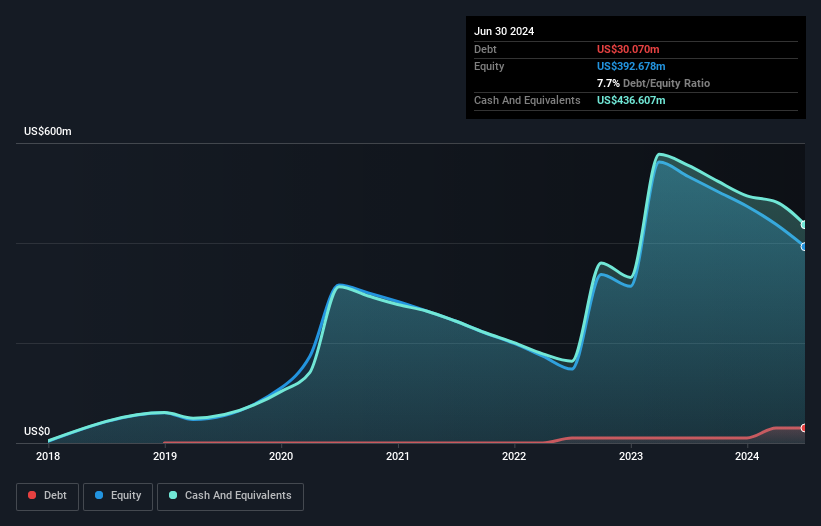
Warren Buffett famously said, 'Volatility is far from synonymous with risk.' It's only natural to consider a company's balance sheet when you examine how risky it is, since debt is often involved when a business collapses. As with many other companies Pliant Therapeutics, Inc. (NASDAQ:PLRX) makes use of debt. But should shareholders be worried about its use of debt?
When Is Debt A Problem?
Debt and other liabilities become risky for a business when it cannot easily fulfill those obligations, either with free cash flow or by raising capital at an attractive price. In the worst case scenario, a company can go bankrupt if it cannot pay its creditors. While that is not too common, we often do see indebted companies permanently diluting shareholders because lenders force them to raise capital at a distressed price. By replacing dilution, though, debt can be an extremely good tool for businesses that need capital to invest in growth at high rates of return. The first step when considering a company's debt levels is to consider its cash and debt together.
Check out our latest analysis for Pliant Therapeutics
What Is Pliant Therapeutics's Net Debt?
You can click the graphic below for the historical numbers, but it shows that as of June 2024 Pliant Therapeutics had US$30.1m of debt, an increase on US$9.99m, over one year. But it also has US$436.6m in cash to offset that, meaning it has US$406.5m net cash.

How Healthy Is Pliant Therapeutics' Balance Sheet?
Zooming in on the latest balance sheet data, we can see that Pliant Therapeutics had liabilities of US$30.9m due within 12 months and liabilities of US$60.1m due beyond that. On the other hand, it had cash of US$436.6m and US$2.80m worth of receivables due within a year. So it actually has US$348.4m more liquid assets than total liabilities.
This surplus strongly suggests that Pliant Therapeutics has a rock-solid balance sheet (and the debt is of no concern whatsoever). Having regard to this fact, we think its balance sheet is as strong as an ox. Succinctly put, Pliant Therapeutics boasts net cash, so it's fair to say it does not have a heavy debt load! When analysing debt levels, the balance sheet is the obvious place to start. But it is future earnings, more than anything, that will determine Pliant Therapeutics's ability to maintain a healthy balance sheet going forward. So if you're focused on the future you can check out this free report showing analyst profit forecasts.
Given it has no significant operating revenue at the moment, shareholders will be hoping Pliant Therapeutics can make progress and gain better traction for the business, before it runs low on cash.
So How Risky Is Pliant Therapeutics?
We have no doubt that loss making companies are, in general, riskier than profitable ones. And in the last year Pliant Therapeutics had an earnings before interest and tax (EBIT) loss, truth be told. And over the same period it saw negative free cash outflow of US$140m and booked a US$185m accounting loss. But the saving grace is the US$406.5m on the balance sheet. That kitty means the company can keep spending for growth for at least two years, at current rates. Even though its balance sheet seems sufficiently liquid, debt always makes us a little nervous if a company doesn't produce free cash flow regularly. There's no doubt that we learn most about debt from the balance sheet. But ultimately, every company can contain risks that exist outside of the balance sheet. For example Pliant Therapeutics has 4 warning signs (and 2 which are a bit unpleasant) we think you should know about.
At the end of the day, it's often better to focus on companies that are free from net debt. You can access our special list of such companies (all with a track record of profit growth). It's free.
New: Manage All Your Stock Portfolios in One Place
We've created the ultimate portfolio companion for stock investors, and it's free.
• Connect an unlimited number of Portfolios and see your total in one currency
• Be alerted to new Warning Signs or Risks via email or mobile
• Track the Fair Value of your stocks
Have feedback on this article? Concerned about the content? Get in touch with us directly. Alternatively, email editorial-team (at) simplywallst.com.
This article by Simply Wall St is general in nature. We provide commentary based on historical data and analyst forecasts only using an unbiased methodology and our articles are not intended to be financial advice. It does not constitute a recommendation to buy or sell any stock, and does not take account of your objectives, or your financial situation. We aim to bring you long-term focused analysis driven by fundamental data. Note that our analysis may not factor in the latest price-sensitive company announcements or qualitative material. Simply Wall St has no position in any stocks mentioned.
About NasdaqGS:PLRX
Pliant Therapeutics
A biopharmaceutical company, discovers, develops, and commercializes novel therapies for the treatment of fibrosis and related diseases.
Excellent balance sheet low.
Market Insights
Community Narratives



